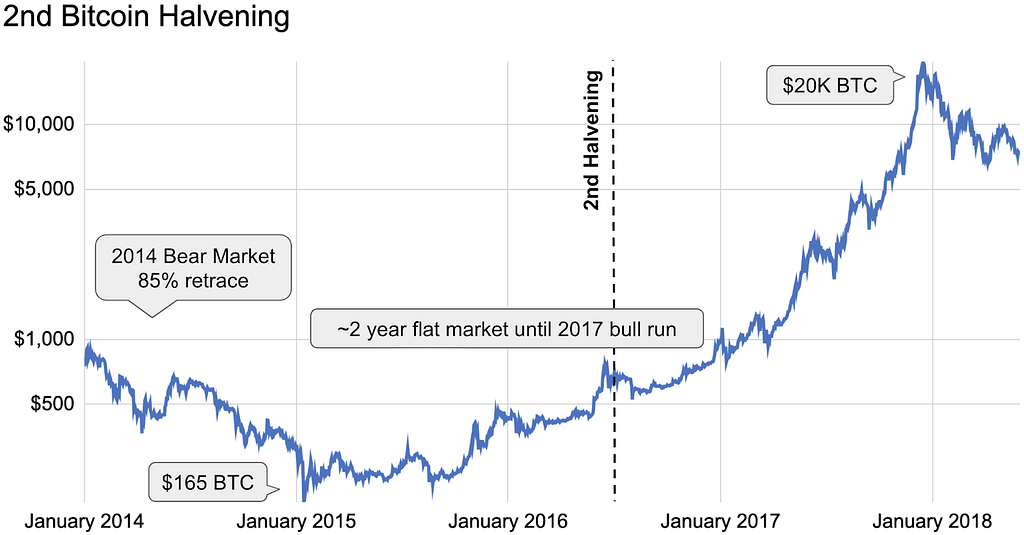Things You Need to Know about the Bitcoin Halving, Ethereum’s Competitors Nearing Launch, and other Crypto News
Coinbase Around the Block sheds light on key issues in the crypto space. In this edition, we reveal key takeaways from the upcoming Bitcoin halving as well as Ethereum’s newest competition.

A Lead Up to the 3rd Bitcoin Halving
To date, Bitcoin has undergone two halvings (2012 and 2016), and we are quickly approaching the third.
For background, Bitcoin pioneered a deflationary economic model by setting an upper limit of 21 million bitcoins. In order to spur adoption, issuance was initially set at 50 BTC per block (every 10 minutes), and set to decay in half every four years as the network presumably grows more valuable. This event is now colloquially dubbed the halving.
Today, 18M Bitcoin have already been mined (86% of the final supply), with 12.5 new BTC (~$125K) issued every block. This will drop in May 2020 to 6.25 BTC (~$63K).
In inflationary terms, this moves Bitcoin from ~3.6% annual inflation to 1.7%, less than USD’s target inflation (2%) and roughly on par with Gold, potentially strengthening the narrative of Bitcoin as digital gold — a new kind of store of value.
Bitcoin Monetary Inflation and Halvings

Following simple supply and demand analysis, each halving decreases supply, and is commonly believed to be a driver for increased price. But what has happened in past halvings, and what can we learn?
BTC’s Momentum After Past Halvings
Bitcoin’s 1st halving occurred in early 2012, when the Bitcoin ecosystem was small, fragile, and volatile.

Following a long sideways market in 2012, the 1st halving itself was anticlimactic but was followed a few months later by a significant bull market. Smashing new all time highs and setting Bitcoin up for an explosive end to 2013, crossing $1300.

Fast forward 4 years, once again Bitcoin was in a long sideways market after falling from the $1300 peak in 2013. The halving itself was again nondescript, but bitcoin began to build strong momentum ~6 months later leading to the unprecedented 2017 run.
3rd Halving on the Horizon
Following the first two halvings, we note that most of the exponential growth occured after the halving. In fact, in each circumstance the halving itself was more of a non-event and any possible impact took ~3–6 months to appear.

Today, for a 3rd time we are in the midst of a long sideways market leading into the halving (although 2019 did see a mini run in the middle, but has since tapered off).
But notably different from past halvings, the crypto ecosystem has significantly matured. Crypto services have made it simple to buy, hold, and use Bitcoin, giving easy access to anyone who wants exposure. On the other hand, it’s also much easier to bet against Bitcoin and go short (via margin, futures, and derivatives). This was difficult in 2016, and completely absent in 2012.
Compared to 2016, crypto has also gained widespread notoriety. Most people have at least heard of bitcoin, and a number of institutions have (at minimum) developed an internal perspective on this asset class.
So is the halving priced in? There are generally two schools of thought:
- Yes. The halving is a byproduct of Bitcoin’s public and well-known economic model. All public information is priced-in to efficient markets, and this is no different.
- No. The halving is a narrative more than anything else, and may influence demand more than supply by driving increased awareness and adoption.
Key Takeaways for the upcoming BTC Halving
Studying prior Bitcoin halvings is a fascinating insight into market behavior and the evolution of Bitcoin as a new asset class. What will happen during and after the next halving? Anyone predicting the future is ultimately guessing, so we’ll have to wait and see. At minimum, the coming halving should produce a strong current of Bitcoin press, opinions, and theories.
Overview on Ethereum Competitors Nearing Launch
Throughout 2015–2017, several projects raised funds to develop general purpose smart-contract blockchain platforms, owing to 1) perceived market demand; 2) technical differentiators they might develop; and 3) expected challenges Ethereum might encounter.
It quickly became apparent that building novel smart-contract platforms is exceedingly complex, and nearly all platforms experienced significant delays (including ETH 2.0). Today, some of the most anticipated platforms are finally on the cusp of deployment.
Here’s an overview of some upcoming projects:
DFINITY
DFINITY aims to build a decentralized “Internet Computer,” where they would enable the public Internet to natively host backend software, transforming it into a global compute platform. Internet services would then be able to install their code directly on the public internet and dispense with all servers, cloud services, and centralized databases.
There are many implications to this idea, notably revolving around decentralizing the web and enabling open innovation, but also creating a path to autonomous software such as open versions of Facebook or LinkedIn. As a side-effect, it may also carry potentially improved security models and remove IT complexities and costs, among other things. If successful, this would be a powerful paradigm shift in how the internet operates.
To accomplish this, DFINITY has assembled a strong team of technologists and published some breakthroughs in consensus mechanisms to enable larger throughput (Threshold Relay).
Polkadot
Polkadot targets building an interoperability network, aiming to enable blockchain projects to:
- Trustlessly transfer assets between different chains;
- Enable cross-chain smart contracts that can interact with each other; and
- Provide a framework to quickly spin up application-specific chains that can be used by other blockchains.
Interoperability is a key building block for the crypto ecosystem. By way of example, it could enable crypto-kitties to create a specific blockchain with massive throughput (so you can breed those kittens as fast as you want), but your crypto-kitties could be accessed by Ethereum, and your platform could use ETH, Dai, or any other ERC-20 token (or possibly ETH infrastructure) natively.
The early days of web servers may be a helpful analogy. Back then, a single server hosted several web pages. If any page exploded in popularity, it slammed the whole server and took down all other web pages with it. The internet evolved to segregated, application-specific servers enabling each web page to scale as needed, without impacting anyone else. Replace web pages with blockchains, and this is just one aspect of what interoperability and application specific chains might do for crypto.
Polkadot is led by Gavin Wood (co-founder of Ethereum) via Parity. Their approach is conceptually similar to Cosmos, but differentiated in how their interoperability network handles security.
NEAR Protocol
NEAR is similar in vision to Ethereum 2.0: A proof-of-stake, sharded blockchain with smart contract functionality, but with a twist in consensus design that better protects composability — or the ability for smart contracts to seamlessly interact with each other across shards. Coinbase Ventures is an investor in NEAR.
The NEAR team, a collection of ICPC medalists, believe targeting dapp developers is critical to long-term traction and are emphasizing the developer experience. Their goal is to launch a truly scalable chain with seamless developer tooling and with a built-in ETH → NEAR bridge so end-users can still use ETH tokens (and possibly ETH infrastructure), which would lower barriers to adoption.
In essence, NEAR is similar to ETH 2.0 but built on a new chain and new environment, thus forfeiting some of the significant network effects ETH has acquired. NEAR is planning a launch in Q2 this year.

Takeaways
Each ETH competitor also faces an uphill climb competing against the strong network effects Ethereum has accrued around infrastructure, tooling, distribution, and mindshare.
In the end, each new protocol’s launch is simply the beginning of a much longer journey. And in the long run, these networks could add new functionality to the wider crypto protocol layer, broadening the crypto design space and increasing the potential for impactful dapps.
This website contains links to third-party websites or other content for information purposes only (“Third-Party Sites”). The Third-Party Sites are not under the control of Coinbase, Inc., and its affiliates (“Coinbase”), and Coinbase is not responsible for the content of any Third-Party Site, including without limitation any link contained in a Third-Party Site, or any changes or updates to a Third-Party Site. Coinbase is not responsible for webcasting or any other form of transmission received from any Third-Party Site. Coinbase is providing these links to you only as a convenience, and the inclusion of any link does not imply endorsement, approval or recommendation by Coinbase of the site or any association with its operators.
Unless otherwise noted, all images provided herein are by Coinbase.
Things You Need to Know about the Bitcoin Halving, Ethereum’s Competitors Nearing Launch, and… was originally published in The Coinbase Blog on Medium, where people are continuing the conversation by highlighting and responding to this story.
via The Coinbase Blog - Medium https://blog.coinbase.com/things-you-need-to-know-about-the-bitcoin-halving-ethereums-competitors-nearing-launch-and-f8b25acc127f?source=rss----c114225aeaf7---4
No comments:
Post a Comment